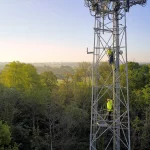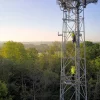OneWeb and Panasonic to Put Faster Broadband WiFi on Airlines

British-registered firm OneWeb, which is building a global constellation of compact Low Earth Orbit (LEO) based ultrafast broadband satellites, has reached an agreement that will see the Panasonic Avionics Corporation work to market, sell, and support the rollout of their in-flight internet services to commercial airlines worldwide.
OneWeb has so far launched 428 of their small c.150kg Low Earth Orbit (LEO) based ultrafast (100Mbps+) and low-latency (sub-100ms) broadband satellites into space – orbiting at an altitude of around 1,200km – and their initial plan is to build a constellation of 648 (588 are needed for coverage – the rest are for redundancy), which is enough for a reasonable level of global coverage.
The company is already heavily involved in the aviation sector and has an ambition to become a key supplier of backhaul broadband capacity for in-flight WiFi services on commercial aircraft (here, here, here and here). In keeping with that, the new deal with Panasonic is important because they’re one of the leading global suppliers of in-flight entertainment and connectivity (IFEC) solutions (i.e. they serve more than 70 of the world’s leading airlines).
Advertisement
Panasonic Avionics will offer OneWeb’s global service standalone or paired with Panasonic Avionics’ award-winning GEO service, which covers 99.6% of the world’s flight routes. The first OneWeb equipped aircraft under this deal are due to enter service during the second half of 2023. Panasonic will thus make its catalogue of cloud-enabled, broadband-connected applications available over the new network, including mobile phone connectivity, ARCTM moving map, ZeroTouchTM content management, and related services.
Ben Griffin, OneWeb VP Mobility Services, said:
“Our mission at OneWeb is to enable airlines to deliver a consistent, terrestrial-like connectivity experience to their passengers, no matter when or where they are flying – over oceans, over the North Pole – absolutely everywhere. This connectivity experience will drive value through enhanced passenger satisfaction and loyalty. This agreement with Panasonic is significant for OneWeb, as it allows us to leverage their reputation, expertise, and reach to bring our LEO network to airlines, while seamlessly integrating our connectivity solution within existing IFEC infrastructure.”
John Wade, VP of Panasonic Avionics’ In-flight Connectivity Unit, said:
“Airline passenger expectations, and therefore the demands of our airline customers, continue to change. Passengers are accustomed to high-speed, low-latency connections supporting remote collaborative working environments, high-quality video streaming, and real-time gameplay. With OneWeb, we can now offer that experience everywhere our customers fly. This is a truly exciting day for the in-flight connectivity market.”
The best existing in-flight systems, which are usually dependent upon satellites in a high geostationary orbit (GEO), tend to reach up to around 50-100Mbps on download (capacity that must be shared with many users over WiFi) and often suffer extremely slow latency times (e.g. 600-4000ms). By comparison, a recent in-flight test conducted by OneWeb delivered 260Mbps download and 80Mbps upload, with latency of under 100ms.
However, officially speaking, OneWeb said their commercial product will support forward link speeds approaching 200Mbps and return link speeds up to 32Mbps everywhere, including polar routes.
Mark is a professional technology writer, IT consultant and computer engineer from Dorset (England), he also founded ISPreview in 1999 and enjoys analysing the latest telecoms and broadband developments. Find me on X (Twitter), Mastodon, Facebook, BlueSky, Threads.net and Linkedin.
« Netomnia Start Fibre Rollouts in Newport, Huntingdon and Sleaford






















































will I have free early access to this service as a tax payer?
Broadband WiFi? They’re two separate things
Ryanair and Eastjet will charge for it as an added extra.
No thank you.